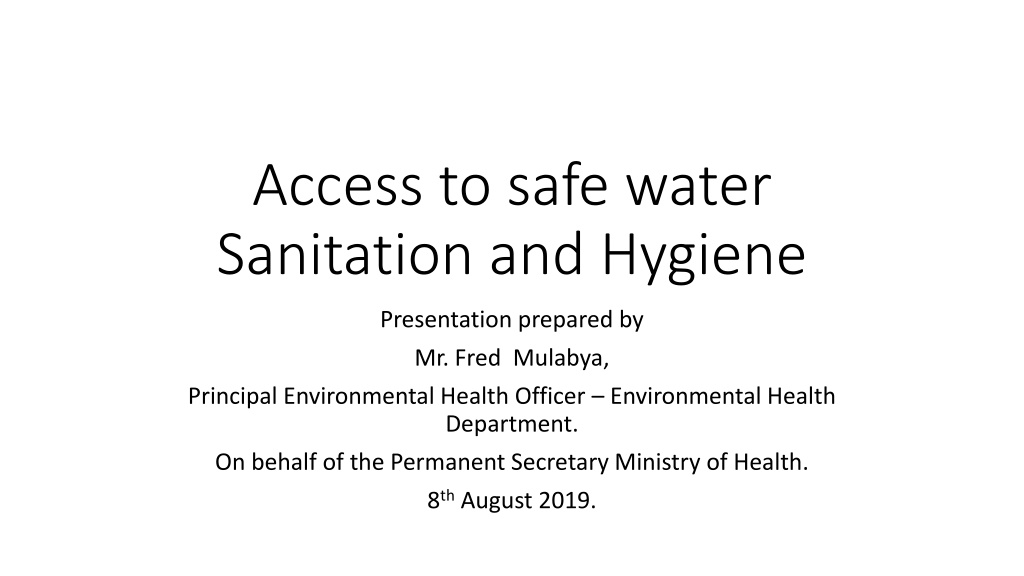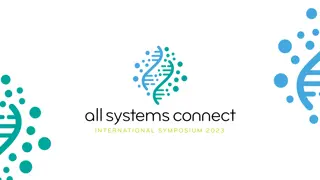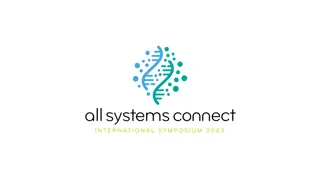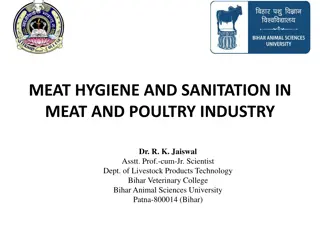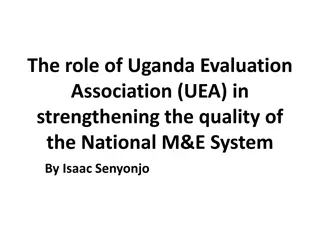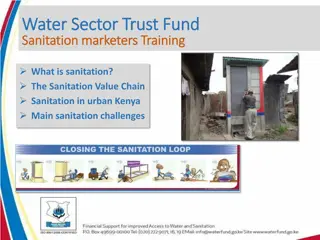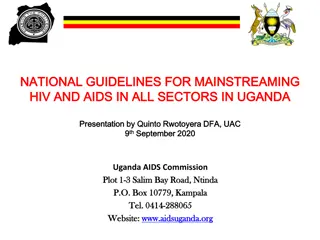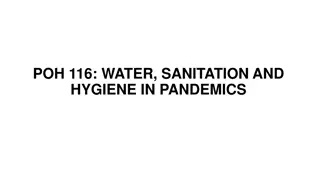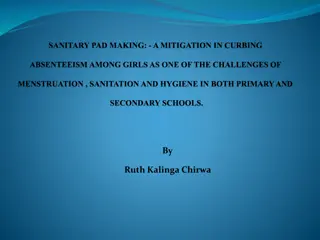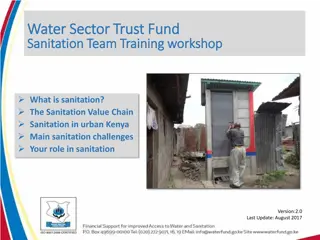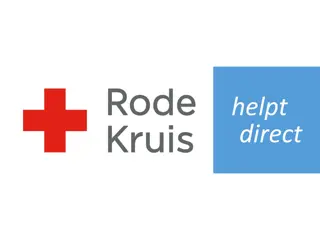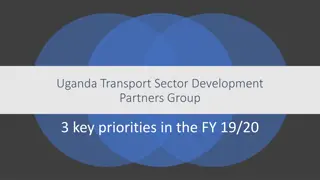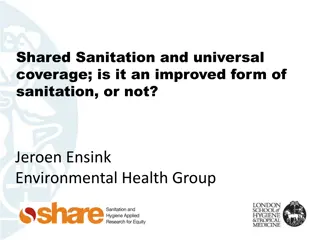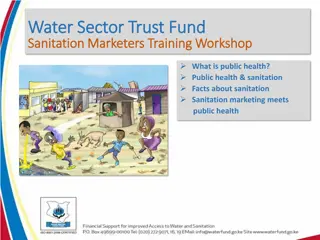Uganda's Sanitation and Hygiene Situation: Challenges and Progress
Uganda's current sanitation profile highlights key issues and initiatives to improve access to safe water, sanitation, and hygiene. Challenges such as low latrine coverage, open defecation rates, and poor handwashing practices persist, but national and district-level strategies are in place to address these issues through policies, community-led initiatives, and capacity building efforts.
Download Presentation

Please find below an Image/Link to download the presentation.
The content on the website is provided AS IS for your information and personal use only. It may not be sold, licensed, or shared on other websites without obtaining consent from the author. Download presentation by click this link. If you encounter any issues during the download, it is possible that the publisher has removed the file from their server.
E N D
Presentation Transcript
Access to safe water Sanitation and Hygiene Presentation prepared by Mr. Fred Mulabya, Principal Environmental Health Officer Environmental Health Department. On behalf of the Permanent Secretary Ministry of Health. 8thAugust 2019.
Definitions Safe water: Wholesome water that is free from micro organisms that could cause disease in a human being when consumed, used for bathing or for washing utensils. Safe water chain: The process of keeping water safe from the water source to consumption, often water quality tests indicate that water that was of good quality at source becomes contaminated during collection, transportation, and storage. Sanitation: The process where people demand, develop, and sustain a hygienic and healthy environment for themselves by erecting barriers to prevent the transmission of diseases. It includes practising good personal hygiene, domestic, and food hygiene and the safe management of solid and liquid waste, vector and vermin control. Hygiene: Refers to behaviours that can improve cleanliness especially the environment, personal, domestic and food hygiene.
Ugandas current sanitation profile Sanitation is a key health determinant in contributing to significant reduction in morbidity and mortality rates in the country Sanitation and hygiene services in Uganda are delivered through a multi- sectoral approach, by various line ministries (MoH, MWE, MoLG and MoES), district local governments as well as CSOs. Funding is by Government of Uganda, Development Partners, the private sector and households. Current Latrine coverage countrywide is at 79%, however, improved latrine coverage (limited) stands at 21%-as per JMP score. Open Defecation is at 8%. Hand washing remains as low as 36.5%. Pupil stance ratio is at 73:1 against the national standard of 1:15-in Boarding schools and 1:25 for the as per the Public Health Act (2000) Day schools Safe water coverage in rural areas stands at 70%.
Delivery mechanisms for sanitation and hygiene services At National level, the Integrated Sanitation and Hygiene Financing Strategy-ISHFS-, offers overall guidance in planning, implementing and evaluating Sanitation and hygiene services. It has three Pillars .i.e. Demand creation, Supply chain improvement, and Creation of an Enabling Environment Key National outputs on sanitation and hygiene improvement include; Developing and reviewing policies (Standards, guidelines, regulations), Technical support supervisions to district and capacity building of staffs , resource mobilisation, monitoring and evaluation At District level policy interpretation and implementation is carried out. Key approaches utilised include; Community Led Total Sanitation (CLTS), Participatory Hygiene and Sanitation Transformation (PHAST), Home improvement Campaigns (HIC), School Inspection Visits, School Health Clubs and enforcement using Public Health Act 2000, Ordinances, Bye-Laws and village resolutions (Community led enforcement).
Priority areas for sanitation and hygiene sub- sector for next five years Finalising the review of the PHAct 2000 and reviewing the regulations thereunder Review of existing EH Policy Development of the Sanitation Policy covering (Urban and Rural) Developing Real Time Data Management Information System for Sanitation to feed into the HMIS Launching National Cleaning Days and developing guidelines to operationalise this initiative Holding National Sanitation Conference Developing National CLTS Hub Eliminating Open Defecation and Accelerating access to Basic Sanitation and Hygiene Services Addressing inequality and discrimination in access to sanitation and hygiene services
Strength and Achievements Divine call towards clean environment Duet 23; 12-14 Goodwill from Development Partners towards supporting sanitation Existence of partners coordination mechanisms at national (NSWG) and districts (DWSCC) Global concerns: SDGs, WES, WSS Declaration Support and participation of Community based organisations and NGOs Uganda Sanitation Fund (Global Sanitation Fund/Water Supply and Sanitation Collaborative Council) Project support to districts in improving access to sanitation and hygiene in communities UNICEF support to WASH activities targeting district based activities H.E. Initiative on health lifestyle prioritizing sanitation and hygiene as a key health determinant
Challenges Limited transport means for extension services at district and National level Inadequate funding to sanitation and Hygiene as a sub-sector Inadequate human resource for effective service delivery at all levels Negative taboo, myths cultural beliefs and practices in communities on sanitation and hygiene Sanitation regarded as an after thought thus not prioritised
Conclusions Sanitation and hygiene have great impact on health and welfare of the Public Sustainable sanitation is anchored on behavioural change and cannot be achieved by merely constructing toilets. Therefore sanitation software component should be adequately funded Inter-sectoral collaboration and partnerships are key in creating synergies towards achieving universal sanitation coverage Sharing experiences, identification of what works and what doesn t and subsequate scaling up of these is very important
